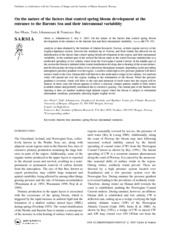On the nature of the factors that control spring bloom development at the entrance to the Barents Sea and their interannual variability
Journal article
Permanent lenke
https://hdl.handle.net/1956/415Utgivelsesdato
2003-12Metadata
Vis full innførselSamlinger
- Geophysical Institute [1198]
Originalversjon
https://doi.org/10.1080/00364820310003145Sammendrag
Analysis of data obtained by the Institute of Marine Research, Norway, at their regular surveys of the Fugløya-Bjørnøya section, between the northern tip of Norway and Bear Island, has allowed for an identification of the factors that control spring bloom development in the region, and their interannual variability. In the southern part of the section the bloom starts as the waters become stratified due to a northward spreading of low salinity water from the Norwegian Coastal Current. In the middle part of the section the bloom is initiated when vernal stratification develops due to heating of the ocean surface, and the bloom may develop in either of two directions throughout summer, depending on the prevailing atmospheric pressure gradient over the region. A north to south high to low pressure gradient will direct surface winds to the west. Ekman drift will then be to the north and a wedge of low salinity, low nutrient water will spread out over the region, leading to the termination of the bloom. When the pressure gradient is reversed, winds will blow to the east and intrusion of fresh water into the region will be limited. In these years the bloom appears to follow a classical Atlantic pattern, unable to fully utilize available nitrate and probably terminated due to extensive grazing. The central part of the Barents Sea Opening is thus yet another northern high latitude region where the bloom is subject to substantial interannual variations, potentially affecting higher trophic levels.
